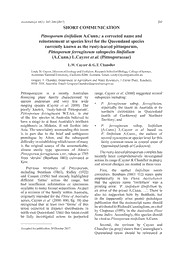
Pittosporum tinifolium A.Cunn.: a corrected name and reinstatement at species level for the Queensland species currently known as the rusty-leaved pittosporum, Pittosporum ferrugineum subspecies linifolium (A.Cunn.) L.Cayzer et al. (Pittosporaceae) PDF
Preview Pittosporum tinifolium A.Cunn.: a corrected name and reinstatement at species level for the Queensland species currently known as the rusty-leaved pittosporum, Pittosporum ferrugineum subspecies linifolium (A.Cunn.) L.Cayzer et al. (Pittosporaceae)
Austrobaileya 10(1): 205–206 (2017) 205 SHORT COMMUNICATION Pittosporum tinifolium A.Cunn.: a corrected name and reinstatement at species level for the Queensland species currently known as the rusty-leaved pittosporum, Pittosporum ferrugineum subspecies linifolium (A.Cunn.) L.Cayzer et al. (Pittosporaceae) L.W. Cayzer & G.T. Chandler Lindy W. Cayzer, Division of Ecology and Evolution, Research School of Biology, College of Science, Australian National University, Canberra 0200, Australia. Email: [email protected] Gregory T. Chandler, Department of Agriculture and Water Resources, 1 Crewe Place, Rosebery, NSW 2018, Australia. Email: [email protected] Pittosporaceae is a mostly Australian range, Cayzer et al. (2000) suggested several flowering plant family characterised by subspecies including: narrow endemism and very few wide • P. ferrugineum subsp. ferrugineum, ranging species (Cayzer et al. 2000). The reportedly the taxon in Australia at its poorly known, ‘rusty-leaved Pittosporum’, northern extremities in Queensland Pittosporum ferrugineum W.T.Ait., is one (north of Cooktown) and Northern of the few species in Australia believed to Territory; and have a range to at least Australia’s northern neighbours in Malesia, if not further into • P. ferrugineum subsp. linifolium Asia. The uncertainty surrounding this taxon (A.Cunn.) L.Cayzer et al. based on is in part due to the brief and ambiguous P. linifolium A.Cunn., the earliest of protologue by Aiton, and the subsequent several synonyms at species level for this difficulty in establishing which taxon of many fairly common taxon in coastal areas of is the original source of the unremarkable, Queensland (south of Cooktown). almost sterile type specimen of Aiton’s The rusty-leaved pittosporum complex has Pittosporum ferrugineum s.str., taken in 1795 recently been comprehensively investigated from ‘shrubs’ (Bentham 1863) cultivated at across its range (Cayzer & Chandler in prep.), Kew. and several changes are needed in these taxa. Previous reviewers of Pittosporum, First, the epithet linifolium needs including Bentham (1863), Ridley (1922) correction. Bentham (1863: 112) states quite and Cooper (1956) had already highlighted emphatically in his Flora Australiensis different ‘forms’ across the range, but that the species name ‘linifolium’ was a had insufficient information or specimens printing error: ‘P. tinifolium (linifolium by available to make formal separations. As part an error of the press) A.Cunn. …’. There is of a revision of the family within Australia, also no suggestion here by Bentham, nor originally intended for the Flora of Australia in the (apparently error prone) protologue series, Cayzer et al. (2000: 890, fig. 18) also publication that the manuscript name should recognised that at least two ‘forms’ of this be attributed to Richard Cunningham, as cited taxon occurred in disjunct distributions in by Chapman (1991), in the Australian Plant north-east Queensland. Until this taxon could Name Index. Accordingly, this species should be fully investigated across its purported be cited as Pittosporum tinifolium A.Cunn. Second, the revision by Cayzer and Accepted for publication 30 October 2017 Chandler (in prep.) shows that Cunningham’s Queensland taxon should be reinstated at 206 Austrobaileya 10(1): 205–206 (2017) species level. Pittosporum ferrugineum Pittosporum tinifolium is functionally s.str. sensu W.T.Aiton occurs in northern dioecious, with inflorescences of aggregated Australia north of Cooktown in Queensland umbels of male or female flowers held and in the Northern Territory. P. ferrugineum prominently above the surrounding vegetation is now known to be uniquely ± monoecious on slender, nodding stalks. A key to the with few flowered inflorescences held barely two ‘rusty-leaved’ Pittosporum species in past the surrounding foliage. Cunningham’s Northern Queensland follows: 1 Leaves elliptic to almost orbicular, thick-coriaceous, upturned, apices rounded or acute; inflorescences multi-flowered stalked umbels exserted well past surrounding foliage. Common and endemic to coastal areas south of Cooktown, in Cook, North Kennedy and Port Curtis districts, Queensland . . . . . . . . . . . . . . . . . . . Pittosporum tinifolium 1. Leaves narrow elliptic to elliptic, thin-coriaceous, downturned, apices tapering, terminating in an acuminate drip tip; inflorescences from single flowers to fewer flowered umbels barely past the surrounding foliage. In Australia, sporadic in coastal areas north of Cooktown in Queensland (including islands in the Torres Strait) and Kakadu, Northern Territory . . . . . . . . . . . . . . . . . . . . . . . Pittosporum ferrugineum Acknowledgements ChApmAn, A.D. (1991). Pittosporum Gaertner (nom. cons.). Australian Plant Name Index K–P: The current investigation of this family 2297–2300. Australian Flora and Fauna Series was funded by a joint Australian Biological Number 14. Australian Government Publishing Resources Study Australian Churchill Service: Canberra. Foundation Fellowship in 2016. The authors Cooper, r.C. (1956). The Australian and New Zealand also thank Tony Orchard for his information species of Pittosporum. Annals of the Missouri and help on the Cunningham epithet and Botanical Garden 43: 87–188. protologue issues. CunninGhAm, A. (1840 publ. Oct 1839). XIII. – Florae Insularum Novae Zelandiae Precursor; or a References Specimen of the Botany of the Islands of New Zealand. Annals of Natural History 4: 106–110. Aiton, W.t. (1811). Pittosporum. Hortus Kewensis or, a Catalogue of the Plants Cultivated in the Royal riDLey, h.n. (1922). Order X11. Pittosporeae. The Flora Botanic Garden at Kew 2nd edition ii: 27–28. of the Malay Peninsula 1: 135–136. L.Reeve & Longman et al.: London. Co.: London. BenthAm, G. (1863). Order X11. Pittosporeae, Flora Australiensis 1: 109–114. L.Reeve & Co: London. CAyzer, L.W, Crisp, m.D. & teLforD, i.r.h. (2000). Revision of Pittosporum (Pittosporaceae) in Australia. Australian Systematic Botany 13: 888–890. CAyzer, L.W. & ChAnDLer, G.t. (in prep.). Unravelling the ‘rusty leaved’ Pittosporum complex (Pittosporaceae: Pittosporum ferrugineum W.T.Ait.) in Eastern Indonesia and Papua/New Guinea.
